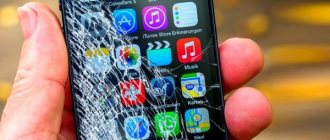You can buy it at a children's store. We will use a suction cup to level the surface of the smartphone.
Procedure:
- You need to attach a suction cup to the edge of the spot. If it does not stick well to the screen, moisten the surface of the suction cup;
- Using sharp, but not strong movements, pull the suction cup towards you so that the upper part of the screen lags behind the bottom;
- Attach the suction cup to the other edge and do the same;
- Depending on the size of the spot, the suction cup must be attached to different ends of the defect.
With these steps you will get rid of the flaw in your phone's sensor. The suction cup can completely fix such faults on tablets, mobile phones and touch screen desktops.
This may be useful: How to open the cover of a BQ phone?
What's that black spot on your phone?
The black spot that appears on many phone screens is not the only problem.
The truth is that even today, screens are made significantly differently and are subject to unique problems.
Even among two identical phones, you may have black spots that look the same but are caused by completely different problems.
Together we'll look at the most common causes of black spots so you can see what's really going on here.
Dead Pixels
Dead pixels are probably the most common reason why you'll see a black spot (or spots) on your screen.
Pixels are individual light sources that allow your screen to create images.
Almost all pixels today are illuminated by LEDs. These are semiconductors that come in all shapes and sizes and emit light. For your phone screen, LEDs will emit red, blue or green light. Other components on the screen will then turn the countless light sources on the screen into the image you see.
When pixels die, they don't emit any light, so the dead spot will appear black while images are displayed on the screen.
Many things can lead to dead pixels. Sometimes they burn out. They are most often damaged by impact or exposure to elements that can harm them (such as water).
Typically, dead pixels are not propagated. If a pixel dies, it does not take other pixels with it.
So, if you have a few dead pixels, that means there's an additional problem, which we'll discuss a little later.
Stuck Pixels
Now that you know a little more about how pixels work, you might not be surprised to learn that they can get stuck.
Because other components must tell the pixels what to do to create an image, these instructions can get mixed up.
When this happens, the pixel may become stuck. It will be the wrong color or turned off when it should be doing something else.
This is most common with liquid crystal displays (LCDs). The liquid crystals actually tell the pixels what to do, and communication problems can occur that result in dark spots appearing on the screen.
Again, this doesn't usually spread over time, but it can behave like this. The good news is that this is one of the easiest things to fix, and the solution will be explained in a minute.
Pressure
Speaking of LCD screens, they can struggle with external pressure.
If you've ever pressed an LCD screen, you've probably seen colors distort and darken under your fingers.
This isn't a problem with modern phones because the touchscreen is thick and rigid enough that touching it doesn't put much pressure on the LCD portion of the screen.
The problem of pressure usually arises from the other side. If something swells or flexes inside the phone, it can create internal pressure. This can cause dark spots to appear, and these dark spots are definitely prone to spreading.
LCD components
Without pressure, LCD components may be damaged and cause dark spots.
In particular, LCD displays contain a plurality of tubes that contain liquid crystals. These tubes can break, allowing fluid to leak out. When this happens, you will see a dark spot on the screen.
More importantly, the dark spot will be present even when the screen is turned off. This is a discoloration that occurs due to leaking tubes and it means that your phone's screen is in poor condition.
Additionally, the liquid may continue to spill and expand over time, so this is an issue that can cause the dark stain to spread across the screen.
Battery fault
After prolonged use, some batteries swell. Increasing the size of the built-in battery pushes out other electronic components, deforms the case and damages the LCD display. Soon spots and other unpleasant artifacts appear, interfering with the perception of information from the screen. In most cases, it is impossible to get rid of stains on your own.
Why is the Black Spot Spreading?
So, some causes of dark spots are more likely to spread, while others don't do so as much. Why?
What actually causes darkness to move across the screen?
It comes down to a few reasons. If dead pixels spread across the screen, it means that something continues to damage more and more pixels over time.
Essentially, this means your screen is cracked and the crack is spreading.
Just like with a windshield, cracks in the glass can form webs and spread throughout the glass. On the phone, this can result in more and more dead pixels.
If the pixels are simply stuck, it means the control problem is getting worse.
In the case of LCD backpressure, the pressure increases over time to spread the darkness. This almost always means the battery is swelling and deteriorating (which is much less common with new lithium-ion batteries).
In the latter case, when the liquid crystal tubes break, the released liquid can create pressure inside the screen structure. This can cause more tubes to burst and you get a domino effect where the dark spot on the screen grows and grows.
Local overheating
This phenomenon is typical for devices where the manufacturer did not take care of proper heat dissipation. In the place where the device overheats, the films are deformed. This is also due to the fact that the film is constantly exposed to high temperatures. After the smartphone cools down, the film does not return to its original shape. Moreover, in the place where overheating occurred, the display will need to be replaced.
In most cases, the place where stains occur is at the ends of the display. They are characterized by a yellow tint, which becomes lighter closer to the edges. Overheating spots do not change their shape and after a certain period of time they may appear even larger.
How to fix a creeping black spot on your phone?
Now that you have an idea of what causes the black spot to appear on your phone and contributes to its spread, we can explore ways to solve this problem.
Since there are different reasons for a stain to appear, solutions must be tailored to the cause.
So, we'll break it down for the reasons and show you the most reliable options for getting your phone screen back to like new condition.
Each case has its own and professional fixes.
Recovering Stuck Pixels
Stuck pixels are actually the easiest to fix on this list.
The problem lies in the digital control mechanisms. This means you can peel off pixels using software.
You can go to your app store or several websites and search for a stuck pixel repair tool.
It will run from a few seconds to 10 minutes.
What it does is switch between pixel controllers to reset the mechanism.
Once everything is reset, the pixels will come unglued and the screen will work normally again.
Pressure Relief
When the problem is the LCD pressure, you need to go into the phone to find the source of that internal pressure. This means removing the screen.
There are DIY kits and tutorials you can follow, but phone repair shops and experts can do it if you're not comfortable.
Most likely, the pressure comes from a swollen battery. If removing the battery stops the swelling, you have identified the problem. Replace the battery and everything will be fine.
If the problem is not the battery, you will need to look for signs of bent or damaged components that may be pressing against the screen. Unbending or replacing these components will relieve the pressure.
Sometimes, even after you relieve the pressure, the problem persists. This means that the pressure was enough to damage the LCD tubes and you will need to make additional repairs.
Dead pixel
When the pixels are dead, the software cannot fix the problem.
You will need to repair or replace damaged pixels. In almost all cases, this means you need to replace the screen.
Technically, individual pixels can be replaced, but they are so small on modern screens that it's not worth the time and money to replace individual pixels.
The tools and expertise needed to do this are expensive and hard to find.
On the other hand, screen replacement is quite affordable.
You can purchase a DIY screen replacement kit or take your phone to a repair shop.
Either way, the cost of replacing a screen is usually less than replacing the entire phone.
If your phone is old enough, this may be a good excuse to upgrade.
When you replace the screen, you get rid of the dead pixels, so the problem is solved.
Actions in case of stains
The only reasonable solution when this malfunction occurs is to use the services of a specialized service center. In most cases, it is not possible to solve such problems on your own due to the fact that you will need to have the appropriate skills and equipment.
To check your phone screen, the best option would be to contact the service center specialists directly, who, using modern technology, will be able to perform a high-quality replacement of the display. At the same time, smartphone owners can be sure that only original spare parts are used.
Matrix cracked
This defect is observed after 40% of gadget falls. When dropped, the integrity of the matrix or glass is damaged, which leads to the appearance of white, black and red stripes on the screen. The user can detect cracks by touch or visually.
p, blockquote 12,1,0,0,0 –>
If there is a crack in the matrix, the only solution is to replace the screen. The cost of the screen module is high, and in some cases it is cheaper to purchase a new device than to replace the screen.
p, blockquote 13,0,0,0,0 –>
Precautionary measures
To avoid such unpleasant consequences, you need to follow the basic rules for using equipment. Smartphones should not be dropped, wet, charged using an inappropriate adapter, or disassembled unnecessarily. You should not give them as a toy to small children, or install applications from suspicious sources. An even better solution would be to install a program that blocks ads, then the phone will definitely not be harmed.
And of course, it’s worth purchasing high-quality equipment. Otherwise, it’s pointless to even be surprised by another breakdown, because nothing else can expect such a “miracle” from the owner.
What to do if the black dot appears again after pressing
You used a suction cup, this way you managed to get rid of the stain on the screen of your smartphone. But after some time or immediately after pressing it, it appeared again. This happens when the touchscreen on the inside can compress either the insulation elements (if the smartphone has already been repaired). Or if the smartphone battery has increased as a result of long-term use. There are two ways out of this situation: either you try to fix the problem yourself by replacing the battery or insulation inside, or you send it to a service center for repairs.
If you decide to solve the problem yourself when a black or dark spot appears on the screen of your mobile phone, you need to get rid of it only after turning off the device. Do not operate the gadget while the power is on. You should not experiment with a smartphone if you have no previous experience in repairing it. The parts inside are very fragile. And their repairs in the future can be too expensive.
Software failure
The easiest option to resolve is incorrect operation of the software. In this case, the spots or stripes that appear usually have a bright color (black or white are extremely rare). You also often have to deal with the fact that different images “overlay” each other. There are several possible root causes:
- incorrect skin update;
- incorrect installation of software;
- infection of the system by a virus.
Among the universal resolution methods: reinstalling the software, resetting the settings to factory settings. If you suspect that you are dealing with a virus, it is recommended that you scan your system with several antivirus systems. If these methods do not lead to success, you will have to contact a specialist.











